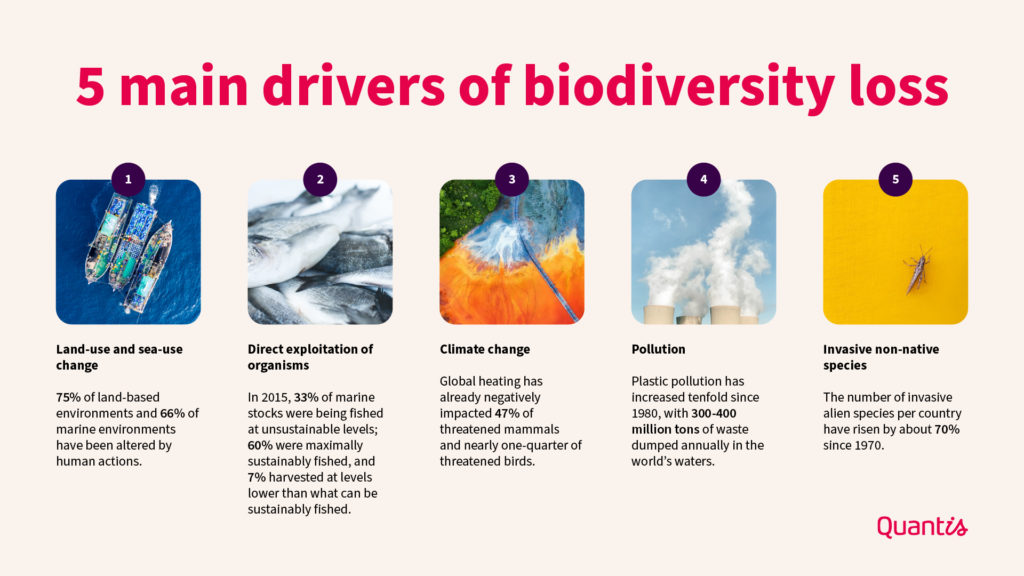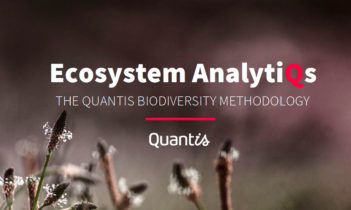
Nature should be the north star for companies that are serious about future proofing their businesses and making real progress on their environmental goals.
In brief:
-
Nature generates US$150 trillion annually in the form of ecosystem services.
-
Many business activities, particularly those related to resource extraction and cultivation, are major drivers of biodiversity loss.
-
If businesses fail to rein in biodiversity loss, they’ll have to brace themselves for massive disruptions to their operations, supply chains and the economy as a whole.
- Companies that take action on climate change and biodiversity loss are better positioned to mitigate major physical, regulatory, reputational and market risks.
Biodiversity and business go hand in hand: more than half of global GDP — a whopping US$ 44 trillion — depends on nature and its services. Yet its value is often overlooked, with companies focusing the bulk of their efforts on cutting carbon emissions.
Tackling the climate crisis is critical — 18% of global GDP will take a hit if nothing is done to address it. But if businesses fail to rein in biodiversity loss they’ll have to brace themselves for massive disruptions to their operations, supply chains and the economy as a whole.
But it’s not an “either-or” situation. It’s “both-and.” Climate change and biodiversity loss are two sides of the same coin; they’re intertwined through mechanistic links and feedbacks. Action taken to address one could have synergies and trade off effects on the other. Climate change exacerbates risks to biodiversity, while ecosystems and their biodiversity are key for climate mitigation and adaptation.
Which is exactly why companies that set integrated environmental strategies that address both climate change and biodiversity are better positioned to mitigate major physical, regulatory, reputational and market risks and realize the best versions of their business.
Sounds good, right? But what is biodiversity, exactly?
An interconnected web of everything
Biodiversity is the most complex feature of our planet and it’s the most essential. But when we talk about biodiversity, what are we actually describing?
Put simply, biodiversity is the variety of life on earth in all its forms and how it interacts. It refers to the number of species, their genetic variation and how they interact with each other and the physical world around them.
The world’s stocks of natural assets are our natural capital — from forests and rivers to the soil and the air that we breathe — and the benefits we derive from them are ecosystem services. These services range from raw materials and food to animals and microorganisms that provide essential “regulating services,” such as pollination and water purification. Together, they provide the foundation of our economies and human life.
Without biodiversity, we can’t have the healthy ecosystems that we rely on for the air we breathe, the food we eat, the medicines we need for physical and mental health, the clothes we wear and much, much more.
And here lies the problem: biodiversity loss — the loss of life on Earth at various levels, ranging from declines in the number, genetic variability and variety of species to the collapse of entire ecosystems — is in free fall. Experts now believe we’re in the midst of a sixth mass extinction. And it’s happening at a rate 10 to 100 times faster than the extinction event that led to the dinosaurs’ demise. The shift, however, is subtle; the impacts become glaringly clear when it’s already too late. That bodes badly for people, planet and business.
Big risks and high stakes
The biodiversity crisis is a business crisis. Nature underpins the global economy, generating economic value in the form of ecosystem services worth over US$ 150 trillion annually. Yet, many business activities are also major drivers of biodiversity loss — particularly those tied to resource extraction and cultivation. And here’s what that means: companies are effectively undermining their own resilience and contributing to the demise of their very businesses. Loss of biodiversity and ecosystem services can push up costs, heighten risks and cause performance to take a nose dive. We’re already seeing this play out; decline in ecosystem functionality costs the global economy trillions every year in the form of lost natural resources.
The OECD has identified a cornucopia of risks for companies that put biodiversity on the backburner:
- Operational (i.e., supply chain disruption or deteriorated supply)
- Liability
- Regulatory
- Reputational
- Market (i.e., changes to consumer preferences)
- Financial
In Europe, big regulatory changes are already underway that could shake things up for businesses, sooner rather than later. The EU Green Deal, which includes a strategy to support nature-based solutions, is currently being phased in, while the Taskforce on Nature-related Financial Disclosures (TFND) is slated to be introduced by the end of the year. The TFND will provide a framework for corporate and financial institutions to assess, manage and report on their dependencies and impacts on nature. It’s expected to be used by investors in much the same way as the Task Force on Climate-Related Financial Disclosures (TCFD) to avoid being exposed to stranded assets in the form of companies that have retained an interest in fossil fuels.
Other regulatory reforms are also expected. COP15 — the 15th meeting of the Conference of the Parties (COP15) of the UN Convention on Biological Diversity — is slated to offer new guidance on protecting biodiversity. Elsewhere, new stricter rules on commercial land use are anticipated, along with an overhaul of the subsidy systems, and a slew of new taxes and fines.
As such, tackling biodiversity loss is more than just an opportunity to “do good” — it’s an imperative for business survival. Need evidence? Look no further than the Canadian cod fishery, whose collapse crushed the economy of Newfoundland and Labrador and put 30,000 people out of work. The Aral Sea crisis offers another cautionary tale. In the 1950s, the Aral Sea was the fourth largest sea on Earth and supplied one-sixth of all the fish consumed in the Soviet Union and its canneries exported products worldwide. In the 1960s, the Soviet Government diverted the Sea’s two main sources of water income to irrigate the desert region around the sea for cotton and wheat production. The water level in the Aral Sea declined drastically from the 1960s onward. By 1970 only 10% of the sea remained, resulting in the collapse of the region’s fishing industry, a lack of potable water, soil salinization and the formation of man-made desert: the Aral-kum.
“Biodiversity is integral to everything we do. In the push for net zero, we are at risk of ignoring its importance and, as a result, endangering businesses and lives. Nature should be the north star for companies that are serious about future proofing their businesses and making real progress on their environmental goals.” — Edith Martin, Quantis Global Biodiversity Solutions and Strategy Lead
Turning crisis into opportunity
The good news is that it’s not all bad news. It’s not too late to reverse the trend of biodiversity loss. Companies that act now to align their business models and practices with nature can seize major opportunities to: mitigate supply chain risks, generate cost savings, increase their market share, boost their value proposition and profitability, create new operational synergies, and foster trust with consumers and investors — who are taking note of brand owners delaying action on nature.
Perhaps most importantly, by prioritizing nature, companies can make significant headway on other critical and interrelated environmental topics, which also happen to be the primary drivers of biodiversity loss:
- Climate change
- Land-use and sea-use change
- Natural resource use and overexploitation
- Pollution of soil, water and air
- Invasive non-native species

Tackling biodiversity loss is a massive undertaking, but it’s feasible and can yield some pretty amazing results. Yacouba Sawadogo, a farmer from Burkina Faso and winner of the 2018 Right Livelihood Award and 2020 UNEP Champions of the Earth award, provides an example of what’s possible. Known as “the man who stopped the desert,” Sawadogo modified a traditional cultivation technique called Zaï (growing crops in pits that trap rainfall and filling them with organic matter during the dry season) in the 1980s to regenerate soil during a period of severe drought that led to lower productivity and yields, and as a result, devastating famine. Using his modified Zaï method, he was able to improve the soil quality and crop yield significantly, and has since created a 40-hectare forest on what four decades ago was degraded, barren land. The forest now has more than 60 species of bushes and trees, as well as an abundance of wildlife.
Aligning business with nature
So, what can businesses and brand owners do to bolster biodiversity? Transform the way they do business. Here’s how to get started:
1. Understand your reliance and impact on biodiversity.
Knowing where to start is half the battle. You can’t begin to tackle biodiversity loss effectively until you know how your business impacts it. And it’s not enough to consider owned operations, companies also need to look at the operations of their suppliers and how consumers use and dispose of their products and services.
A biodiversity impact assessment that integrates local considerations addressing climate change, water depletion, pollutant emissions and land use can give companies a big picture view of their impacts across the entire value chain, allowing them to identify the commodities and activities putting the most pressure on nature, as well as the locations and ecosystems they concern.
Companies in land-based industries, in particular, should take note. Agriculture and food production are the primary causes of biodiversity loss worldwide. The conversion of land for agriculture, and the intensification of the way we farm, has decimated the quality and quantity of habitat. Agriculture isn’t only a concern for the food and beverage industry. The cosmetics and personal care sector, for instance, relies on biodiversity for ingredients and packaging. The same is true of the fashion and sporting goods sector, with its demand for cotton, leather, wool and viscose.
And yet, agricultural intensification has resulted in large-scale losses of biodiversity and ecosystem services, as well as widespread homogenization of plant diversity, leaving businesses incredibly vulnerable to supply chain disruptions related to climate change and its impacts. Just 11 crops produce 95% of the natural fibres we use to clothe ourselves. Cotton accounts for 24% total fiber production, with only four of the 50 existing species of cotton used for cultivation. One species, Gossypium hirsutum, represents 90% of global cotton production. Homogenization has implications for human health as well, limiting dietary variety. Today, only 17 species — 12 plants and five animals —make up 75% of the world’s food.
Agriculture also has negative impacts on freshwater wildlife, through downstream pollution, especially fertilizer run-off, and is also, of course, a major contributor of greenhouse gas emissions. But despite the fact that nature is critical for food and agriculture businesses, the more chemical inputs we add to the soil, the more we degrade the land, putting billions of dollars of crops at risk. That’s a vicious circle.
But it’s not just agriculture for which biodiversity has become a material issue — nature is a finite and fragile resource that all businesses need and have impacts on. The impacts of biodiversity loss will be felt by businesses across sectors. Understanding your impacts and dependencies will help you determine which issues to prioritize, set meaningful objectives, and develop a science-driven strategy, and deploy a subsequent plan of action.
2. Set an integrated environmental strategy.
Biodiversity doesn’t exist in a vacuum. Everything is interrelated and interdependent. Companies with separate strategies for critical environmental topics are missing out on opportunities to drive real progress and running the risk of creating unintended impacts. To reverse nature loss, businesses must take a systems approach, addressing climate change and land-use change — two of the main drivers of biodiversity loss — as well as water scarcity and ocean pollution.
An integrated environmental sustainability strategy that sets objectives for not only biodiversity loss, but also other planetary boundaries (climate, water, land use, etc.), and is aligned with business strategy better positions businesses to maximize their positive impact while minimizing tradeoffs.
Defining mechanisms to track and measure progress is vital to keep up momentum, ensure the effectiveness of efforts and initiatives, and monitor the long-term impact on ecosystem health. Companies should publicly disclose information about its progress, making it available to investors, regulators and consumers through the appropriate channels, to foster trust and mitigate reputational and regulatory risks.
3. Build a strong foundation for success.
An ambitious, science-driven strategy isn’t enough if you don’t have the internal structures and mechanisms in place to put it into action.
Businesses that make biodiversity everybody’s business — not just the sustainability team’s responsibility — can expect to see big returns on their investment, while those that stick to the status quo are more likely to see their strategies flounder. Creating the ideal conditions for your integrated environmental strategy to thrive requires
- Engaging internal and external stakeholders (including suppliers, investors and board members) about the importance of biodiversity and providing them with training and tools that will allow them to integrate biodiversity concerns into their day to day and decision making
- Holding everyone accountable for biodiversity outcomes by setting departmental targets and KPIs
Regardless of industry, geography or position in the value chain, businesses have an essential role to play in reversing the trend of biodiversity loss and enhancing ecosystem vitality — and a lot to lose from apathy. It’s time to translate intention into action and align your companies’ operations with nature to safeguard the future of people, planet and business.
Related resources

Sustainability must be at heart of business continuity to avoid disruption in times of crisis
Times of crisis have the potential to unleash a tempest that could jeopardize corporate sustainability efforts.
 Report
Report By Quantis
Ecosystem AnalytiQs: the Quantis biodiversity methodology
Quantis shares its biodiversity method for evaluating companies’ impacts on biodiversity across the value chain.

Page
Biodiversity
Quantis works with clients to create innovative biodiversity impact assessments that guide effective strategies and actions to tackle biodiversity loss.


